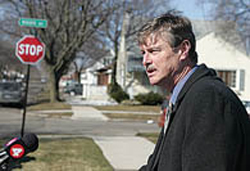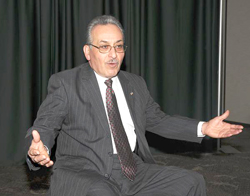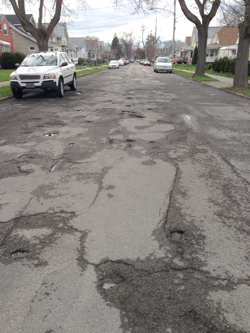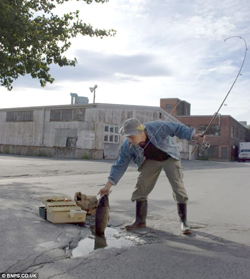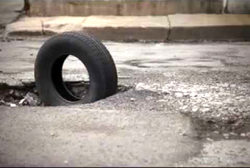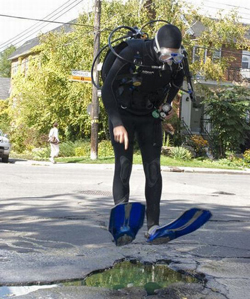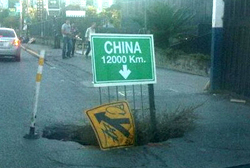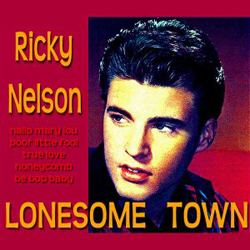There's a Place Called Pothole Town
By Frank Parlato
A survey conducted by this newspaper last week found that more than 85 percent of Niagara Falls city streets that we checked are marred by potholes, major cracks, bumps, and are deteriorating, uneven, hazardous or even dangerous to cars and people.
There are 450 miles of roads in the city, and while the Reporter did not examine all the roads, it was difficult to find any of the roads that we traveled that were not cracked or deteriorating.
With tourist season fast approaching, this makes a terrible first impression on visitors to the Cataract City.
Of 15 major thoroughfares reviewed, we rated nine in poor condition. Lockport, Portage, Buffalo, Ferry, Walnut, Niagara and Whirlpool are among the worst.
But the bigger story perhaps lies in the scores of less frequented roads that people call home, such as Willow near 18th, or Seymour, which are at places nearly impassable.
DPW director Dave Kinney conceded that there are still "hundreds of roads" that need serious work.
In a city that breezed through $69 million in casino money, it is surprising. And it is not as if taxes are too low to get good services, either.
According to a study by the Tax Foundation of Washington, D, C., Niagara County property owners pay the second highest taxes in the nation.
According to some, the reason why roads are so poor in this city is because they are a low priority for Mayor Paul Dyster.
In fact, in Dyster's Capital plan, he only has $650,000 set aside for road maintenance and repair, enough to fix about 25 streets.
"There were millions spent on consultants that should have been spent on roads," said Councilmember Sam Fruscione, part of a three-person majority on the council that voted against some of Dyster's spending requests. "I voted against all of them unless they were connected to road reconstruction or quality of life issues," said Fruscione.
Another member of the council majority, Robert Anderson, agrees.
"The roads are brutal,” said Anderson. “I have been to third world countries during my time in the military that have better roads than we do. When Danny Bristol (city administrator under former Mayor Vince Anello) was here, they did a hell of a better job as far as streets were concerned."
Council Chairman Glenn Choolokian agreed, saying the roads are so bad that the council may have to step in and find the money to fix them.
"We must get a thousand calls, everybody talks about the roads. We have no choice but to run day-to-day operations. You have a mayor that doesn’t run day-to-day operations. The train station, all the guts and glory, is not what we need right now. Potholes, roads, and sidewalks have to be done."
Former Mayor Vince Anello, though no fan of the council majority, agrees with their assessment on roads.
"There is no doubt that fixing roads is something that Dyster thinks is beneath him," Anello said. "He is more into lofty goals, things which, in all truth, don’t affect the day to day lives of the people living in Niagara Falls, but make good headlines, like the train station or the Underground Railroad exhibit."
Mayor Dyster was asked to meet with the Reporter, and said he would be willing to do so, but has not yet scheduled a date.
During both of his mayoral campaigns, Dyster talked about streets and potholes at length.
"Niagara Falls became synonymous with one word more than any other…'potholes,'" Dyster said in 2010. "It's the complaint I heard most when I was running for mayor, and it's the issue that generated the most calls to my office during the early days of my administration."
And when the casino money flowed, the mayor did put some of it into roads.
The city bought an asphalt "zipper machine" that cuts a swath of bad road and seals it, and leased a Pothole Killer, a repaving machine that grinds up bad pavement and hot-patches the resulting hole—50 potholes in one hour.
The leased machine comes with a crew to run it.
In 2008, the Department of Public Works, under the direction of Dave Kinney, paved 155,000 square yards of roads. In 2009, it was 218,000 square yards.
Dyster was quick to mention it as a signal accomplishment.
"Last year, we finally made a dent," he said in 2010. "You couldn't drive anywhere in the city last year without encountering a paving crew. That's because we took on more than 40 paving projects…. We paved and paved and paved some more. . It was a great effort, but it was only the beginning. … Wait until you see our 2010 paving program; it will knock your socks off. But not your hubcaps or tie-rod ends."
In 2010, the mayor's team repaved another 40 streets.
He got major digs going on 72nd Street, 10th Street, and Lewiston Road started, although the latter two were mainly federally funded and were in line from the previous administration and now, under Dyster's management are in litigation.
In 2011 the mayor was running for re-election and he directed Kinney to send crews to pave and patch scores of streets.
While the 300,000 square yards the city paved in 2010 may indeed seem impressive, the city would have actually had to pave 600,000 square yards to keep up with the steady deterioration of roads and perhaps a million square yards per year to get ahead of deteriorating streets.
After he was re-elected in 2011, Dyster said, in words that seem eerily as if he were talking of the present, "Remember when it was almost impossible to find any street in Niagara Falls you could drive down without risking a broken front end? …We invested record amounts fixing our streets. What began with the Pothole Killer gave way to a road repair revolution that has touched every corner of our city. "
Even today Dyster says he's done a good job on roads.
“When I think of the roads that are in really bad shape, it’s a relatively short list, whereas before almost everything was in need of repair and it was easier to tell you what was in good shape,” he says.
But reality is another story, as our survey reveals.
Meantime, he is almost derelict in his attention to the matter.
Last year, the city patched more than 13,000 potholes using the pothole killer. There are an equal number waiting to be patched this year.
Yet Dyster has not proposed the Pothole Killer be used this year. At a cost of $70,000, it can fill more than 200 potholes per day, at less than $10 per pothole.
A DPW crew can fill only 25 potholes per day, according to Kinney. With three men, trucks, safety equipment and material, it will cost more than $25 to fill each pothole. At best 50 potholes can be filled per day, which means that, with the short paving season, and without the pothole killer, it will take two years to fill the existing potholes, not to mention new ones that will form in the meantime.
Yet, as of press time, no plans have been made to secure the pothole killer.
City Controller Maria Brown said that money from the general fund, casino money and also a portion of the bed tax money can be used for fixing the roads. Brown went so far as to say that there probably is money available from a portion of last year's bed tax money that could pay for the pothole killer this year.
The mayor, who has proposed that only 25 roads be repaired this year, despite the fact that hundreds need work, seems detached, being more concerned with the pressing issues of funding the proposed train station.
With $1.5 million, Kinney said, he would be able to double his paving, to 50 roads this year.
But a conflict lies in the fact that the mayor needs $2 million to launch the train station this year, and with money so tight, money spent on road maintenance would preclude using it for the train station.
Enter the council majority. Fruscione said the council will find a way to fix the potholes, even if the mayor is disengaged.
"The council has a contingency fund dedicated to roads, demolitions, sidewalks and trees," he said. "But for what the mayor spent on the train station, studies for the Underground Railroad exhibit, and engineering studies handed out to Buffalo firms, he could have paved a million square yards of roads. You have to put first things first."
Fruscione has a point.
Money that could have been spent fixing the roads over the last several years has gone to: Niagara Arts and Culture Center ($150,000), a blues festival ($26,000), The Ontario Jazz Festival ($30,000), the Boundary Water treaty celebration ($18,000), a celebration of Black History Month, Gospel Fest, the African American festival, Niagara Rises, the LaSalle Yacht club, the HOG rally, the NF Cruisers car club.
The Niagara Tourism & Convention Corporation got $5 million. The Urban Renewal Agency got $2.6 million. The Niagara County IDA got $2 million. Hope VI got $6 million.
As State Sen. George Maziarz said of the latter, "Think of the streets that could be paved with the millions the city spent on this."
Besides the $2 million needed to launch the train station, another $2 million has already been spent.
A total of $1.5 million went to millionaire Faisal Merani so he could improve his hotels with public money instead of using his own. The Rapids Theater got $250,000.
Shorty's, Mary’s Soul Food, Edy J's., Niagara Metals, Erdco, Gadawskis, and assorted gas stations got $375,000. The Red Coach Inn, certainly able to support itself, got $50,000.
Also, $30,000 went to the Buffalo Niagara Economic Development Summit, $21,000 for the National Urban Fellow program. The Ezekiel project got $54,000. The Holiday Market got $225,000. The Hard Rock Concerts were given $657,000. In addition,
$840,000 went for work on the Ice Pavilion, so taxpayers can subsidize the hockey crowd.
The mayor spent big on everything but roads.
In 2013, the mayor has proposed spending another $650,000 on the hockey rink, the exact amount he has budgeted, in his 2013 Capital Projects plan, for road maintenance for the city.
Of course, much of the money meant for roads has already been diverted into his train station project.
His five-year capital plan has four categories: roads, buildings, parks and sidewalks. Curiously, Dyster included the train station under "roads."
The city's two-year contribution to the train station, as listed on the capital plan under roads, is $3,310,966, the single largest investment under the category of roads. Dyster has $966,000 budgeted in his plan for 2103 for consultants, designers and lawyers. Contrast that with only $650,000 for road maintenance.
Of course, there will be some money spent on large projects or "digs" that are paid for by federal DOT funds at 80 percent reimbursement. New York State contributes another 10 to 15 percent. The city pays the remaining 5- 10 percent.
Most of these road projects were initiated by Anello, such as the reconstruction of Buffalo Avenue.
Pine Avenue, Main Street, Packard Road, Pershing, Buffalo Avenue, Lewiston Road, Tenth St, 24th Street and other large jobs that were federal and state reimbursable projects, were initiated by Anello.
Dyster took credit for these in his various state-of-the-city addresses.
Last year, though the mayor did not fund the $70,000 needed to get the pothole killer, he did get Patch Management, the owners of the pothole killer, to agree to perform 320 hours of work repairing potholes and delay their payment until casino revenues were released.
One year later, Patch Management is still not paid, according to City Controller Brown, but DPW chief Kinney said the company would be willing to come back this year provided they are paid.
It seems that it will be up to the council to act; the mayor seems more concerned that any money diverted to roads will slow down or cripple his train station and Custom House plans.
